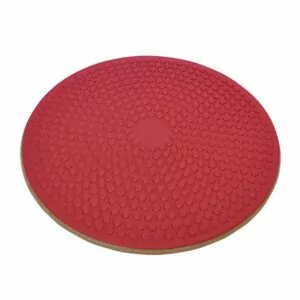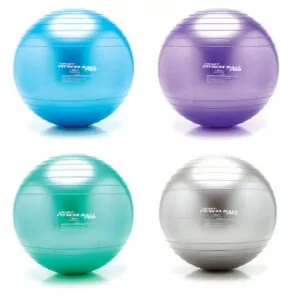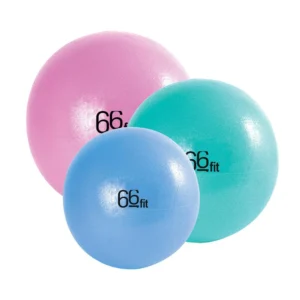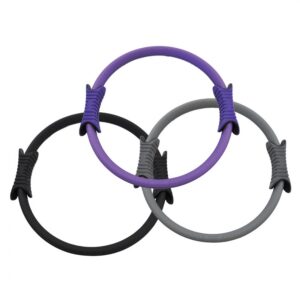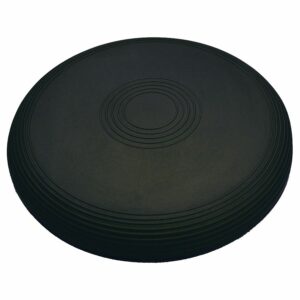Labral Tear
Updated:
(Also known as a Hip Labral Tear, Labral Tear of the Hip)
What is a labral tear?
A labral tear of the hip is a condition characterised by tearing of the connective tissue within the hip joint known as the labrum.
The hip joint is a ball and socket joint – the ball arising from the top of the femur (thigh bone) and the pelvis giving rise to the socket. The depth of the socket of the hip joint is increased by strong cartilage known as the labrum which attaches to the rim of the hip joint (figures 1 & 2).
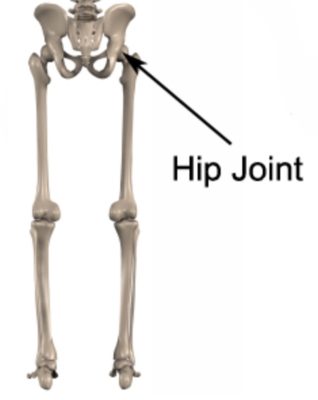
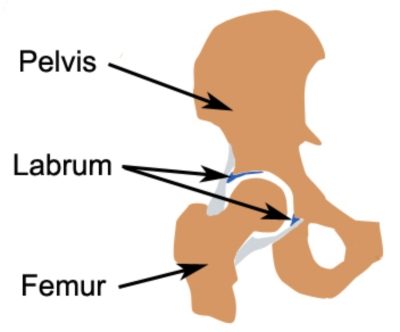
The labrum is responsible for increasing the depth and stability of the hip joint. It also aids shock absorption, cushioning the impact of the femur on the pelvis during weight bearing activity. Normally the surface of the labrum is very smooth allowing easy movement of the femur on the pelvis. Occasionally the labrum can be torn or damaged so that the surface is no longer smooth. When this occurs, the condition is known as a labral tear.
Causes of a labral tear
A labral tear often occurs traumatically in sports that require sudden changes of direction and twisting movements. These sports may include football, soccer, basketball, netball and snow skiing. They may also occur during running or due to direct trauma such as a fall, heavy landing, heavy lifting (especially whilst twisting) or motor vehicle accident.
Occasionally, patients may develop this condition over time through gradual wear and tear associated with overuse. This may be due to excessive twisting or weight bearing activity over time (e.g. long distance walking or running, especially on uneven surfaces or up or down hills or stairs), repetitive squatting or lunging, or, excessive kicking (e.g. in football, dancing or martial arts). In older patients, degenerative changes to the hip joint may also be present. In these instances, injury to the labrum may occur with a relatively trivial movement.
Signs and symptoms of a labral tear
Patients with this condition may report that they heard an audible sound at the time of injury or experienced a tearing sensation. Pain is usually felt in the groin, hip and / or buttock. Symptoms typically increase with weight bearing activity (e.g. excessive walking, running, jumping, lifting or carrying) and twisting movements of the hip. Patients may also experience pain when climbing stairs, getting in and out of the car, lying on the affected side, during kicking or when squatting or lunging. The hip may also feel weak or unstable and may click or lock during certain movements.
In minor cases of this condition there may be little or no immediate symptoms. In these cases, symptoms may develop gradually over the coming days, typically with an increase in weight bearing or twisting activity. In more severe cases there may be severe pain and significant restriction in hip range of movement. Intermittent locking, clicking sensations, and episodes of giving way or collapsing of the hip may be present. The patient may also walk with a limp or, be unable to weight bear due to pain.
Diagnosis of a labral tear
A thorough subjective and objective examination from a physiotherapist is usually sufficient to diagnose a labral tear. Investigations such as X-ray and MRI are often used to confirm diagnosis, assess the severity and exclude the presence of other injuries in the hip. In rare cases, where an MRI has proven inconclusive, an investigative arthroscope may be performed to assist diagnosis.
Treatment for a labral tear

Members Only ContentBecome a PhysioAdvisor Member to gain full access to this exclusive content. For more details see Become a Member. Already a member? Login Now
Surgery for a labral tear

Members Only ContentBecome a PhysioAdvisor Member to gain full access to this exclusive content. For more details see Become a Member. Already a member? Login Now
Contributing factors to the development of a labral tear
There are several factors which may contribute to the development of this condition. These need to be assessed and corrected where possible with direction from a physiotherapist. Some of these factors include:
- inappropriate or excessive training or activity
- inadequate recovery periods from sport or activity
- joint stiffness (particularly of the hip)
- muscle tightness (particularly the gluteals or hip flexor muscles)
- muscle weakness (particularly the gluteals)
- poor foot biomechanics
- inappropriate running technique
- training on inappropriate surfaces (particularly hard, uneven or cambered surfaces)
- inappropriate footwear
- inadequate warm up
- inadequate rehabilitation following a previous hip or lower limb injury
- being overweight
- anatomical anomalies of the hip joint
- leg length discrepancy
- poor core stability
- poor balance
Physiotherapy for a labral tear
Physiotherapy treatment is vital to hasten the healing process and ensure an optimal outcome in all patients with a labral tear regardless of whether they have surgery. Treatment may comprise:
- soft tissue massage
- electrotherapy
- joint mobilization
- stretches
- dry needling
- hydrotherapy
- the use of crutches
- ice or heat treatment
- biomechanical correction (e.g. the use of orthotics)
- activity modification advice
- anti-inflammatory advice
- weight loss advice where appropriate
- education
- progressive exercises to improve flexibility, balance and strength
- clinical Pilates
- a gradual return to running program
- a gradual return to sport or activity program
For those patients who are undergoing surgery for their condition, physiotherapy and rehabilitation should commence prior to surgery. This may include treatment to reduce pain and swelling, electrotherapy, flexibility and strengthening exercises, hydrotherapy and the use of crutches. Following surgery, physiotherapy and rehabilitation is essential to assist the healing process and ensure an optimal outcome.
Prognosis of a labral tear
Those patients with minor labral tears that respond well to conservative management can usually return to sport or activity in approximately 2 – 6 weeks.
For minor tears that are managed surgically, patients can sometimes return to sport or activity within 4 – 8 weeks, although most patients (especially when the tear is moderate to severe) will require a significantly longer rehabilitation period.
It is important that labral injuries are managed appropriately, as inappropriate treatment may lead to the development of early hip osteoarthritis.
Other intervention for a labral tear
Despite appropriate physiotherapy management, some patients with this condition fail to improve either conservatively or following surgery. When this occurs the treating physiotherapist or doctor can advise on the best course of management. This may include further investigations such as X-rays, MRI or CT scan, pharmaceutical intervention, corticosteroid injection, or further surgery.
Exercises for a labral tear
The following exercises are commonly prescribed to patients with this condition. You should discuss the suitability of these exercises with your physiotherapist prior to beginning them. Generally, they should be performed 3 times daily and only provided they do not cause or increase symptoms.
Your physiotherapist can advise when it is appropriate to begin the initial exercises and eventually progress to the intermediate and advanced exercises. As a general rule, addition of exercises or progression to more advanced exercises should take place provided there is no increase in symptoms.
Initial Exercises

Members Only ContentBecome a PhysioAdvisor Member to gain full access to this exclusive content. For more details see Become a Member. Already a member? Login Now
Advanced Exercises

Members Only ContentBecome a PhysioAdvisor Member to gain full access to this exclusive content. For more details see Become a Member. Already a member? Login Now
Other Exercises

Members Only ContentBecome a PhysioAdvisor Member to gain full access to this exclusive content. For more details see Become a Member. Already a member? Login Now
Rehabilitation Protocol for a labral tear

Members Only ContentBecome a PhysioAdvisor Member to gain full access to this exclusive content. For more details see Become a Member. Already a member? Login Now
 Physiotherapy products for a labral tear
Physiotherapy products for a labral tear
Some of the most commonly recommended products by physiotherapists to hasten healing and speed recovery in patients with this condition include:
To purchase physiotherapy products for a labral tear click on one of the above links or visit the PhysioAdvisor Shop.
 Find a Physio for a labral tear
Find a Physio for a labral tear
Find a physiotherapist in your local area who can treat a labral tear of the hip.
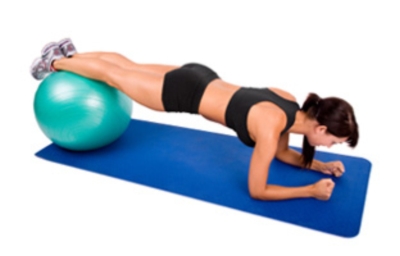 Other exercises
Other exercises
- Hip Flexibility Exercises.
- Hip Strengthening Exercises.
- Core Stability Exercises
- Balance Exercises
- Beginner Pilates Exercises to improve core stability and posture.
 More information
More information
- View detailed information on initial injury management and the R.I.C.E. regime.
- Learn How to use Crutches.
- Read when to use Ice or Heat.
- View our graduated Return to Running Program.
- Do I Need Orthotics?
- View detailed information on Returning to Sport.
- Why is my injury not improving?
- Read our Hip Diagnosis Guide.
Become a PhysioAdvisor Member

Link to this Page
If you would like to link to this article on your website, simply copy the code below and add it to your page:
<a href="https://physioadvisor.com.au/injuries/hip-groin/labral-tear”>Labral Tear – PhysioAdvisor.com</a><br/>Explore hip labral tear causes, signs and symptoms, diagnosis, treatment, exercises, rehabilitation protocol, physiotherapy products and more at Physioadvisor.com.au
Return to the top of Labral Tear.


